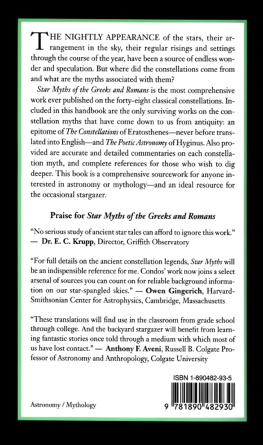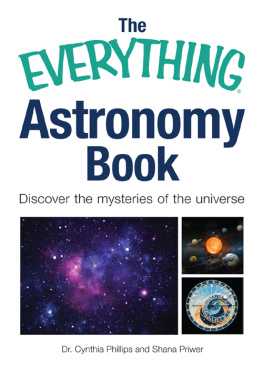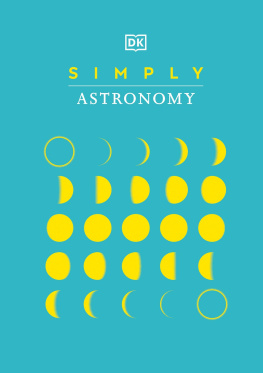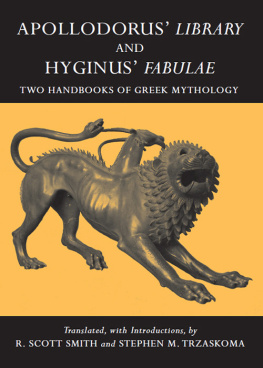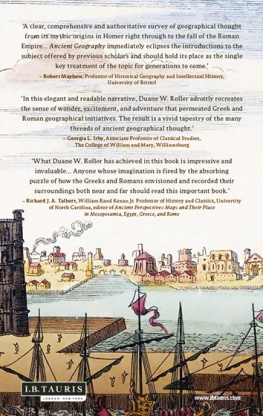Eratosthenes - Star Myths of the Greeks and Romans: A Sourcebook
Here you can read online Eratosthenes - Star Myths of the Greeks and Romans: A Sourcebook full text of the book (entire story) in english for free. Download pdf and epub, get meaning, cover and reviews about this ebook. year: 1997, publisher: Phanes Press, genre: Science. Description of the work, (preface) as well as reviews are available. Best literature library LitArk.com created for fans of good reading and offers a wide selection of genres:
Romance novel
Science fiction
Adventure
Detective
Science
History
Home and family
Prose
Art
Politics
Computer
Non-fiction
Religion
Business
Children
Humor
Choose a favorite category and find really read worthwhile books. Enjoy immersion in the world of imagination, feel the emotions of the characters or learn something new for yourself, make an fascinating discovery.
- Book:Star Myths of the Greeks and Romans: A Sourcebook
- Author:
- Publisher:Phanes Press
- Genre:
- Year:1997
- Rating:3 / 5
- Favourites:Add to favourites
- Your mark:
- 60
- 1
- 2
- 3
- 4
- 5
Star Myths of the Greeks and Romans: A Sourcebook: summary, description and annotation
We offer to read an annotation, description, summary or preface (depends on what the author of the book "Star Myths of the Greeks and Romans: A Sourcebook" wrote himself). If you haven't found the necessary information about the book — write in the comments, we will try to find it.
Star Myths of the Greeks and Romans: A Sourcebook — read online for free the complete book (whole text) full work
Below is the text of the book, divided by pages. System saving the place of the last page read, allows you to conveniently read the book "Star Myths of the Greeks and Romans: A Sourcebook" online for free, without having to search again every time where you left off. Put a bookmark, and you can go to the page where you finished reading at any time.
Font size:
Interval:
Bookmark:


Atlas Faroese
Star Myths of the Greeks and Romans
A Sourcebook
Containing The Constellations of Pseudo-Eratosthenes and the Poetic Astronomy of Hyginus
Translation and Commentary by Theony Condos
Phanes Press
Theony Condos holds a doctorate in classical studies from the University of Southern California. Star Myths ofthe Greeks and Romans is a revised and expanded version of her dissertation, The Katasterismoi of the Pseudo-Eratosthenes: A Mythological Commentary and English Translation.
1997 by Theony Condos.
All rights reserved. No part of this publication may be reproduced or transmitted in any form, with the exception of short excerpts used in reviews, without the permission in writing from the publisher.
Published by Phanes Press, PO Box 6114, Grand Rapids, MI 49516, U.S.A.
Phanes Press website: www.phanes.com
Library of Congress Cataloging-in-Publication Data
Star myths of the Greeks and Romans : a sourcebook containing the Constellations of Pseudo-Eratosthenes and the Poetic astronomy of Hyginus / translation and commentary by Theony Condos.
p. cm.
Includes bibliographical references and index.
ISBN 1-890482-92-7 (alk. paper)
ISBN 1-890482-93-5 (pbk. : alk. paper)
1. Constellations. 2. Astronomy, Ancient. 3. Mythology, Greek. 4. Mythology, Roman. 5. Eratostene. Constellations. 6. Hyginus. Poetic astronomy. I. Eratostene. Constellations. II. Hyginus.
Poetic astronomy.
QB802.S83 1997
398.26--dc21
97-29207
CIP
Printed on permanent, acid-free paper.
Printed in the United States of America.

Preface
The present volume provides an English translation and commentary for two classical texts, the Catasterismi of Pseudo-Eratosthenes (first/second century C.E.), and Book 2 of the Latin work variously titled Poeticon Astronomicon or De Astronomia, which is attributed to Hyginus (first century B.C.E.). Together, these two texts offer a comprehensive picture of the myths associated by the Greeks and Romans with the constellations familiar to them. Those constellations were forty-eight in number by the time of Ptolemy (second century C.E.).
The translation of the Catasterismi follows the edition of Olivieri, which shows, separately, the consensus of readings of the five complete manuscripts and of manuscript R (Venetus Marcianus 444), a partial manuscript that stems from a different archetype than the complete manuscripts and contains some differences from them. Where manuscript R differs significantly from the consensus of readings in the other manuscripts, as for example, in the myth associated with the constellation Corona Borealis, the variant readings of R are identified by angle brackets (<>) in the translation below. Lacunae in the text are identified by square brackets ([]). The translation of the De Astronomia follows the edition of Vir.
Greek and Latin names are retained in form, but the spelling of Greek names is Latinized, e.g., Heracles and Hercules. A list of Greek names and their Latin counterparts is provided in .
The spot illustrations at the beginning of each chapter are taken from woodcuts in the first edition of Hyginus, Poeticon Astronomicon (Venice: Erhard Ratdolt, 1482). In most cases, the illustrations do not accurately depict the location or number of the stars described in the Greek and Latin texts translated below. A more accurate depiction of the constellations can be found in the star maps reproduced in . The reader should also note that most star maps and pictures of the constellations show the constellations as they would appear from the Earth, i.e., from inside the celestial sphere, while many texts describe the figures as they would appear from outside the celestial sphere.
The proposed identification of stars by their modern designation in the translation of the Catasterismi is based on a comparison of the language used in the Greek text and in Ptolemy's Almagest to describe the location of a particular star. Where the descriptions are similar, e.g., there is one star on the head, the star on the head, identification is fairly straightforward. However, when the descriptions do not coincide, e.g., there is one star on the head, the northern most of the three stars on the head, identification is more problematic. In such cases, the star of the greatest magnitude is proposed, followed by a question mark. When the Catasterismi describes a star for which Tere is no corresponding reference in Ptolemy, a question mark appears in the translation. Since Hyginus's descriptions of star locations rarely vary from those in the Catasterismi, an identification is proposed only in those instances when Hyginus's text varies significantly from the Greek. The proposed modern designation of stars listed in Ptolemy's Almagest was derived from two recent works: Paul Kunitzsch, Der Almagest (Wiesbaden: Otto Harrassowitz, 1974) and G. J. Toomer, Ptolemy's Almagest (New York: Springer-Verlag, 1984). It should be noted that the stars enumerated in the Greek and Latin texts do not always coincide with the total number indicated in those same texts.
When the star identified by a modern designation belongs to the constellation that is the subject of the Greek text, no constellation name is indicated. When, however, the star belongs to another constellation, a constellation name is noted, e.g., the stars in the Claws of the Scorpion belong not to the constellation Scorpio, but to the constellation Libra; thus, in the translation of the Greek text that treats Scorpio they are designated as a Lib, 11 Lib, etc., following the standard abbreviations for the names of the constellations listed in .
Thanks are due to David Fideler for his interest in the subject, to Gibson Reaves for encouragement in a distant time and place, to Apostolos Athanassakis for assistance in interpreting a troublesome passage in the Greek text, to Brigitte Cazelles for a perceptive reading of the manuscript, and to Justin Chang for technical assistance. Responsibility for any remaining shortcomings rests, of course, with the author.
Introduction
The campaigns of Alexander the Great during the last half of the fourth century B.C.E. expanded the horizons of the Greek world by bringing Greeks and their culture into direct contact with the civilizations of the Ancient Near East. The ensuing juxtaposition of differing perspectives regarding the state, the gods, and the individual caused learned men throughout the Eastern Mediterranean to reassess their understanding of the world and human experience. An explosion of scientific inquiry and new knowledge resulted that was unequaled until modern times. By the third century B.C.E., Alexandria in Egypt had become one of the principal centers of literary and scientific studies in the Mediterranean world. At the center of this scholarly activity were two institutions: the famous Library, founded by Ptolemy I (311-283 B.C.E.), organized under Ptolemy II (283-246 B.C.E.), and maintained by their successors, and the lesser-known Museum, also established by Ptolemy I, as a residential center for research. The Museum's history is obscureit appears to have been the victim of political tensionswhile the Library, under a succession of learned head librarians including Zenodotus of Ephesus, Apollonius of Rhodes, and Eratosthenes of Cyrene, flourished for over 500 years, until its burning by Aurelian in 272 C.E.
Font size:
Interval:
Bookmark:
Similar books «Star Myths of the Greeks and Romans: A Sourcebook»
Look at similar books to Star Myths of the Greeks and Romans: A Sourcebook. We have selected literature similar in name and meaning in the hope of providing readers with more options to find new, interesting, not yet read works.
Discussion, reviews of the book Star Myths of the Greeks and Romans: A Sourcebook and just readers' own opinions. Leave your comments, write what you think about the work, its meaning or the main characters. Specify what exactly you liked and what you didn't like, and why you think so.

